A review of synoptic weather effects on sea ice outflow through Fram Strait: cyclone vs. anticyclone
2020-03-31LIANGYuBIHaiboWANGYunheZHANGZehuaZHANGYiLIUYanxiaHUANGHaijun
LIANG Yu, BI Haibo, WANG Yunhe, ZHANG Zehua, ZHANG Yi, LIU Yanxia & HUANG Haijun
A review of synoptic weather effects on sea ice outflow through Fram Strait: cyclone vs. anticyclone
LIANG Yu1,2, BI Haibo1,3,4*, WANG Yunhe1,2, ZHANG Zehua1,3,4, ZHANG Yi1,3,4, LIU Yanxia1,3,4& HUANG Haijun1,2
1Key laboratory of Marine Geology and Environment, Institute of Oceanology, Chinese Academy of Sciences, Qingdao 266071, China;2University of Chinese Academy of Sciences, Beijing 100049, China;3Laboratory for Marine Geology, Qingdao National Laboratory for Marine Science and Technology, Qingdao 266237, China;4Center for Ocean Mega-Science, Chinese Academy of Sciences, Qingdao 266071, China
Sea ice outflow through Fram Strait is a vital component of the sea ice mass balance of the Arctic Ocean. Previous studies have examined the role of large-scale modes of atmospheric circulation variability such as the Arctic Oscillation, North Atlantic Oscillation, and Dipole Anomaly in the movement of sea ice. This review emphasizes the distinct impacts of synoptic weather on sea ice export as well as on other relevant fields (i.e., sea ice concentration and sea ice drift). We identify deficiencies in previous studies that should be addressed, and we summarize potential research subjects that should be investigated to further our understanding of the relationship between synoptic weather and sea ice export via Fram Strait. For example, the connection between summertime anticyclones and weakened potential vorticity related to the observed extensive spring Eurasian snow and Siberian Ocean sea ice loss is of considerable interest. In-depth exploration of this type of geophysical mechanism will be particularly useful in assessment of the robustness of such linkages inferred through statistical analyses.
sea ice outflow, Fram Strait, cyclone, anticyclone
1 Introduction
Polar sea ice is a sensitive indicator of global climate change (Lemke et al., 2000; Zhang, 2010; Kerr, 2012; Riihelä et al., 2013; Christensen and Nilsson, 2017; Smith, 2017; Swart, 2017; Ogawa et al., 2018). Current Arctic warming is occurring at a rate twice the global average, which is a phenomenon known as Arctic Amplification (Serreze and Francis, 2006; Serreze et al., 2009; Miller et al., 2010; Serreze and Barry, 2011; Francis and Vavrus, 2012; Screen and Simmonds, 2013; Cohen et al., 2014; Huang et al., 2017). Significant sea ice loss in September plays a vital role in the development of such a warm anomaly in the Arctic (Comiso et al., 2008; Kumar et al., 2010; Screen and Francis, 2016; Ogawa et al., 2018; Wang et al., 2019). Sea ice area change reflects the balance of several physical processes of which sea ice melt and growth processes are the primary basic mechanisms controlling sea ice variability (Perovich et al., 2003; Perovich et al., 2007a, 2007b; Inoue et al., 2008). Additionally, sea ice outflow through Fram Strait modulates sea ice coverage in high-latitude regions of the Arctic. For example, 10% of the total sea ice coverage and most of the multiyear sea ice are exported from the Arctic Ocean via Fram Strait (Jung and Hilmer, 2001; Kwok et al., 2004; Koenigk et al., 2006; Kwok, 2008; Spreen et al., 2009; Tsukernik et al., 2012; Bi et al., 2016, 2018; Smedsrud et al., 2017; Zhang et al., 2017; Ricker et al., 2018; Wei et al., 2018).
This large volume of sea ice exported via Fram Strait leads to fresher upper-level water in the downstream region (Dickson et al., 2002; Jahn and Holland, 2013; Ionita et al., 2016). For example, it triggered the Great Salt Anomaly event that occurred in the Labrador Sea in the early 1970s (Dickson et al., 1988; Häkkinen, 1993). Water column stability in regions with large sea ice inflow and melting can thus be strengthened and vertical mixing processes suppressed (Dickson et al., 1988; Ionita et al., 2016). A direct connection to this effect would be a slower and weaker water circulation process associated with the Atlantic Meridional Overturning Circulation (AMOC) (Jackson et al., 2016; Caesar et al., 2018; Thornalley et al., 2018). However, the specific role of a slower AMOC on climate change remains under debate. Some argue that a weaker and slower AMOC would carry less heat to higher latitudes and could cause a colder response in mid- to high-latitude regions (Vellinga and Wood, 2002; Heiri et al., 2004; McManus et al., 2004; Pohlmann et al., 2006). By contrast, a recent study revealed that a warmer climate could be linked to a slower northward AMOC in the North Atlantic Ocean because of the longer period over which extra heat could be released (Chen and Tung, 2018). Therefore, sea ice outflow through Fram Strait could exert significant influence on regional and even global climate change (Zhang et al., 2007; Robson et al., 2016; Yan et al., 2017; Caesar et al., 2018).
Although the answers remain unclear, the objective of most relevant studies is to address the two following questions regarding sea ice outflow and its far-reaching climatic effects. (1) What are the physical mechanisms that cause the variability and trends of Fram Strait sea ice? (2) Which process constitutes the primary forcing of these mechanisms? Clearly, the varying intensity of the transpolar drift stream (TDS) contributes to sea ice outflow through different gateways into the Nordic Seas(Figure 1) (Stroeve et al., 2011; Haller et al., 2014; Krumpen et al., 2016, 2019). Moreover, wind forcing related to large-scale atmospheric circulation patterns is deemed the main driver of sea ice drift and outflow. Controlled by the prevalent positive phase of the Atlantic Oscillation/North Atlantic Oscillation (AO/NAO) during an earlier period (1979–1995), sea ice outflow via Fram Strait was anomalously high (Kwok, 2000, 2008; Kwok et al., 2013). By comparison, the Dipole Anomaly (DA) appears to account for greater variance of the outflow over the past decade (Watanabe et al., 2006 ; Wu et al., 2006; Wang et al., 2009). This implies a shift of dominant atmospheric circulation mode over the high-latitude Northern Hemisphere and thus the sea ice movement mode is transforming into a new phase (Zhang et al., 2008).
Comparatively, knowledge of sea ice outflow from the perspective of synoptic processes is scarce and inadequate (Koyama et al., 2017; Wernli and Papritz, 2018). Synoptic behaviors explain a notable fraction of the variability in large-scale atmospheric changes (Serreze and Barrett, 2008; Simmonds et al., 2008; Screen et al., 2011, 2013; Zhang et al., 2012). Coincidentally, Fram Strait is located in a region over which cyclonic and anticyclonic maxima commonly occur (Ioannidou and Yau, 2008; Wei et al., 2017). In this circumstance, the influences of synoptic processes on sea ice outflow need to be elucidated further, especially given the recent period of dramatic Arctic sea ice loss (Sepp and Jaagus, 2011).
The remainder of this paper is organized as follows. Section 2 presents the climatological frequency of Arctic cyclones and anticyclones. Sections 3 and 4 describe the variations of sea ice outflow associated with cyclones and anticyclones, respectively. Section 5 provides concluding remarks and it outlines possible future research subjects of interest and necessity.
2 Climatological frequency of synoptic processes
In terms of climatology, Fram Strait is the primary gateway for sea ice outflow from the Arctic Ocean. It spans a distance of approximately 400 km from the northeast tip of Greenland to the west end of Svalbard (Figure 1). Although less important, two other gateways (Svalbard–Franz Josef Land (S-FJL) and Franz Josef Land–Severnaya Zemlya (FJL-SZ)) account for a few tens of percent of the total annual sea ice export from the Arctic Ocean into the Barents Seas (Kwok, 2008). Figure 2 suggests that a significant trend of sea ice drift exists over Fram Strait. Consequently, Fram Strait sea ice outflow is an area of active research regarding climate change (Jung and Hilmer, 2001; Schauer et al., 2004; Simmonds et al., 2008; Müller et al., 2009).
Cyclones and anticyclones are two important synoptic weather processes (that can persist for days to weeks) that could significantly influence the fields of sea ice drift and sea ice concentration (Brümmer and Hoeber, 1999; Brümmer et al., 2008; Simmonds and Keay, 2009; Kriegsmann and Brümmer, 2014; Ionita et al., 2016), as well as sea ice outflow through Fram Strait (Rogers et al., 2005; Wei et al., 2018). Figure 3 shows that Fram Strait is located in an area adjacent to the region where cyclonic maxima occur in all seasons except summer. The Barents Sea is the region with the climatological maximum cyclone frequency. The average autumn (Figure 3a) and winter (Figure 3d) cyclone frequencies are much higher than in other seasons (Figures 3b and 3c). The emergence of a cyclone just to the northeast of the strait would lead to enhanced outflow of sea ice through Fram Strait (Wei et al., 2018) (see Section 3 for further explanation).
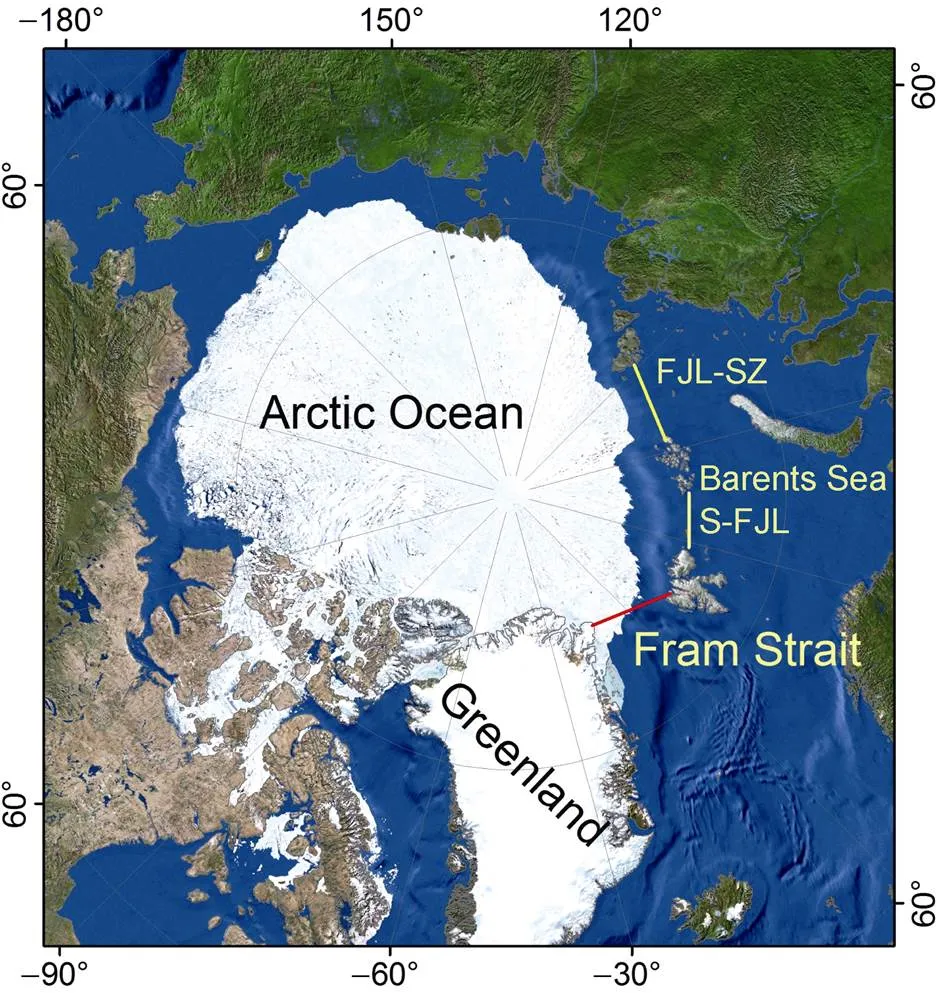
Figure 1 Location of Fram Strait. Red line indicates the fluxgate of the strait. Yellow lines denote the other two fluxgates of Arctic sea ice into the Barents Sea.
Figure 2 Sea ice drift trends (using NSIDC sea ice motion data) in winter (October–May) over 1979–2016. White bold line denotes the fluxgate used in estimates of sea ice outflow through Fram Strait.
Anticyclone occurrence has a maximum frequency over the North Atlantic Ocean and the North Pacific Ocean (Ioannidou and Yau, 2008). Similar to the pattern noted for cyclones, seasonal contrasts are small from autumn to spring but large compared with summer (Figure 4) (Ioannidou and Yau, 2008). Depending on the location of occurrence, the winter maximum anticyclone frequency in the North Atlantic Ocean is able to impede or promote sea ice outflow via Fram Strait (Ionita et al., 2016) (see Section 4 for further explanation). Fram Strait is located in an area with high frequency of occurrence of cyclones (Wei et al., 2017) (Figure 3) and anticyclones (Ioannidou and Yau, 2008) (Figure 4). Therefore, the development and spatial extent of such synoptic processes could give rise to large fluctuation in sea ice outflow via the strait (Brümmer and Hoeber, 1999; Rogers et al., 2005; Wei et al., 2018).
3 Effect of cyclones on sea ice outflow
3.1 Effect of cyclones on sea ice in Fram Strait
Changes in sea ice area flux forced by cyclones are determined primarily by change in sea ice drift and secondly by change in sea ice concentration (Kriegsmann and Brümmer, 2014; Bi et al., 2016). Beginning at the end of the 1980s, multiple observational programs were conducted over Fram Strait to investigate the regional effects of cyclones on sea ice change. These programs included CEAREX in 1989 (Rasmussen et al., 1997), ARKTIS in 1993 (Brümmer and Hoeber, 1999), FRAMZY (1999, 2002, 2007) (Brümmer et al., 2001, 2005; Lammert et al., 2009), the Tara cruise (2007–2008) (Schiermeier, 2009), and the recent N-ICE2015 study (Provost et al., 2017). Field observations indicate that surface winds triggered by cyclones can transfer huge amounts of energy into the movement of sea ice, and that sea ice drift speed on the western and southern sides of cyclones (see below for more details) could be enhanced by approximately 2–3 times (Brümmer et al., 2003).
With the advancement of satellite-based observations, radiometer, scatterometer, and synthetic-aperture radar (SAR) measurements are now used widely in monitoring the thermodynamic and dynamic influences on sea ice attributable to passing cyclones. Lammert et al. (2009) highlighted that sea ice in marginal areas (e.g., Fram Strait) is thermodynamically vulnerable to cyclones that could cause distinct inertial oscillation. Consequently, sea ice concentration could decrease by as much as 11% (as an extreme case) in marginal sea ice areas, whereas the trend only reaches an average of 4% in the central Arctic Ocean (Kriegsmann and Brümmer, 2014). Statistically, sea ice concentration undergoes a greater decrease around the center of a cyclone (−3.0% to 0.2%, Figure 5) (Kriegsmann and Brümmer, 2014).
With respect to dynamic impacts, one specific example is the strong cyclones that occurred in August 2012. In this event, a large amount of sea ice was forced from the central ice pack and pushed into the Pacific sector of the Arctic Ocean, where substantial declines in the concentration and extent of the ice occurred because of extensive melting (Simmonds and Rudeva, 2012; Zhang et al., 2013). Statistical results demonstrate that sea ice drift speed (Figure 6b) is augmented considerably by cyclone forcing (Figure 6a) (Kriegsmann and Brümmer, 2014). This is consistent with the understanding that a cyclone serves as an important driver of change in sea ice drift speed (Olason and Notz, 2014). The area near the center of a cyclone shows the lowest increase in speed because of the minimal wind forcing. However, on the southwestern side of a cyclone, sea ice drift speed can reach a maximum of approximately 18 cm·s−1(see lower-right panel in Figure 6b). Based on the above, it is evident that cyclone passage is generally characterized by enhanced sea ice drift speed and reduced sea ice concentration within its radius, which likely contribute to the apparent variability in sea ice outflow observed by satellite (Kwok, 2008; Bi et al., 2016; Smedsrud et al., 2017).
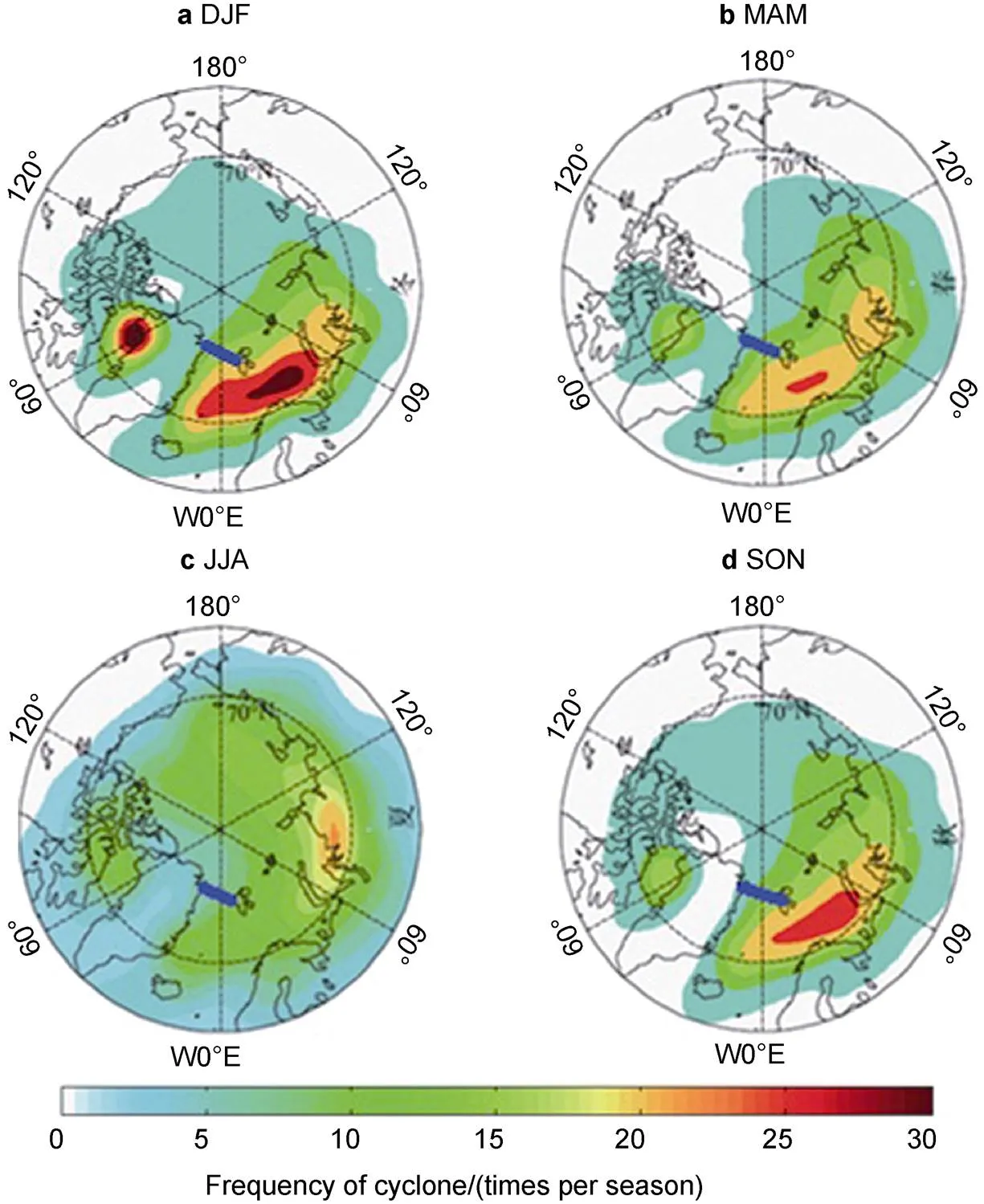
Figure 3 Climatological cyclone frequency (times per season) for different seasons: winter (a, DJF), spring (b, MAM), summer (c, JJA), autumn (d, SON) during 1979–2012. Blue bold line indicates the fluxgate of Fram Strait. Adapted from Wei et al. (2017).
Figure 4 Climatological anticyclone frequency (times per season) for different seasons: winter (a, DJF), spring (b, MAM), summer (c, JJA), autumn (d, SON) during 1979–2007. Contours indicate percent of blockings per season. Black bold line denotes the fluxgate of Fram Strait. Adapted from Ioannidou and Yau (2008).
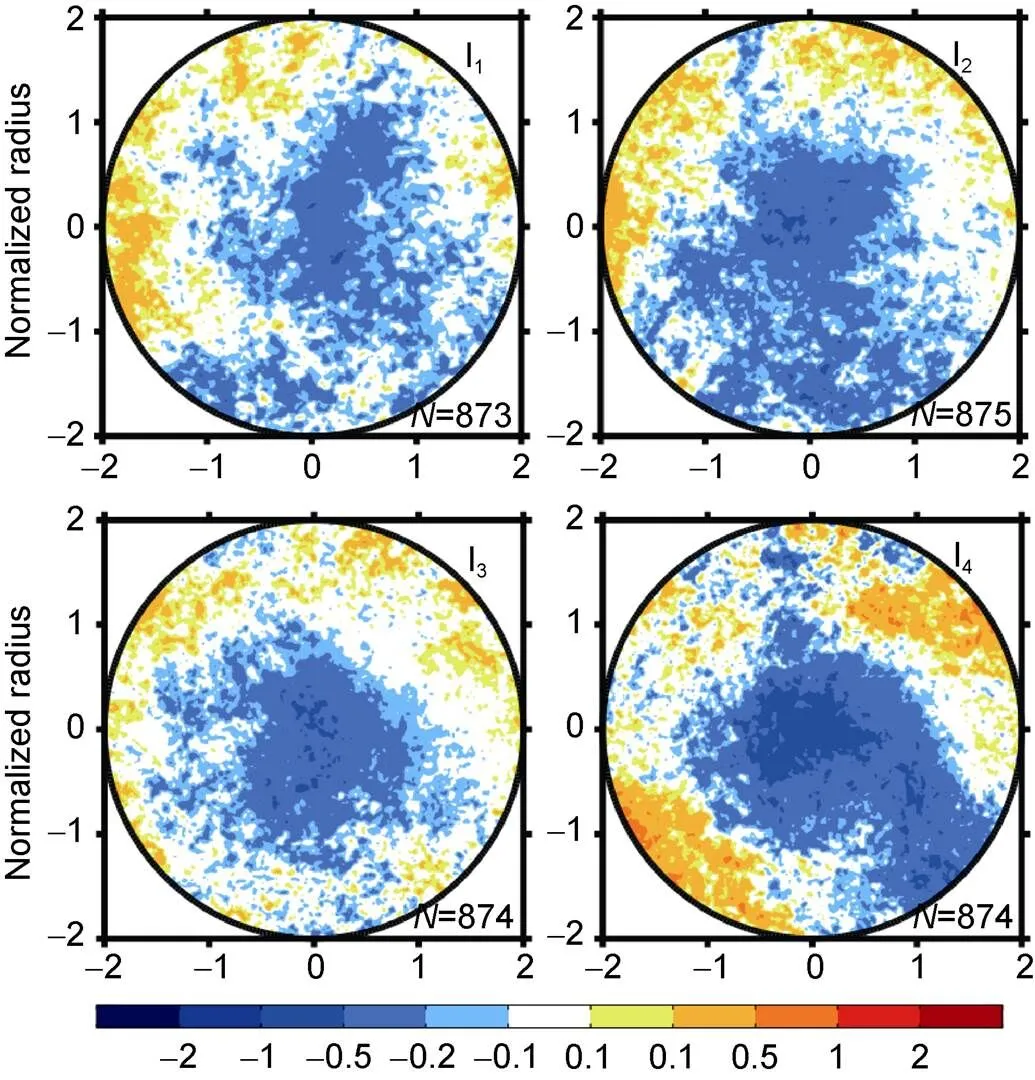
Figure 5 Mean sea ice concentration change within 24 h after passage of cyclones with different intensities (increases from I1to I4). The concentration fields are centered on the location of cyclone detection and normalized with the cyclone radius. Adapted from Kriegsmann (2014).
3.2 Effect of cyclones on sea ice outflow in Fram Strait
Figure 7 suggests that sea ice flux through Fram Strait will be modulated by the passage of a cyclone (Wei et al., 2018). A previous study on the relationship between Fram Strait sea ice outflow and cyclone-induced winds showed that sea ice area flux during 1978–1994 could be increased by an average of 50% if cyclones played a role (Brümmer et al., 2001). Unfortunately, that study considered only closed cyclones, neglecting open cyclones that are important contributors (Simmonds et al., 2008). Hence, the estimate of sea ice outflow could have been underestimated.
The findings of an updated study of Fram Strait sea ice area outflow, which estimated sea ice area flux using nearly 40-year of passive microwave observations, were reported by Kwok et al. (2013). They identified an obvious trend of increased sea ice flux over the recent decade. This recent decadal increase in sea ice area flux was subsequently confirmed independently from SAR observations (Figure 8) (Smedsrud et al., 2017). It is hypothesized that enhanced cyclonic activity to the east of Fram Strait was responsible for the observed increased export of sea ice through Fram Strait (Smedsrud et al., 2017).
In a new insightful study based on the MITgcm- ECCO2 high-resolution global ocean sea ice model, Wei et al. (2018) argued that storm-induced strong northerly wind stress could cause simultaneous response of daily sea ice export and exert cumulative effects on both interannual variability and long-term change of sea ice export. They also highlighted that existence of a spatially dependent feature because storms occurring to the southeast of Fram Strait exhibit the greatest impact on sea ice export (Figure 9). Further analysis has shown that the decrease in the volume of sea ice export since 1994/95 has been caused by the weakened intensity of cyclones in winter (Wei et al., 2018). Therefore, in addition to the significance of intensity (summarized in Section 3.1), cyclone track is also an important influencing parameter of sea ice outflow.
4 Effect of anticyclones on sea ice outflow
Anticyclones have the opposite dynamic impacts on sea ice to cyclonic processes (Ogi and Wallace, 2007). An anticyclone normally induces convergence of sea ice and increased sea ice concentration through the production of ridged ice (Ogi et al., 2008). Nevertheless, comprehensive study of the effect of anticyclones on sea ice outflow remains of considerable interest. Anticyclone activities in the Arctic Ocean started to draw the attention of scientists during the past decade because it was recognized that the Arctic Ocean is becoming increasingly dominated by surface anticyclonic activities (Figures 10 and 11a). As illustrated in Figure 10, sea ice motion within the entire Arctic area (1979–2006) is obviously anticyclonic during summer. This pattern contributes to faster ice drift around the southern arm of the Beaufort Gyre and over the TDS (Figure 10). The anticyclonic form appeared to be maintained throughout the subsequent period of 2007– 2011 (Ogi and Wallace, 2012). Further analysis suggests that the sea level pressure (SLP) distribution, which is responsible for the occurrence of the anticyclone, is a feature with a high degree of anomaly over the Arctic Ocean (Figure 11).
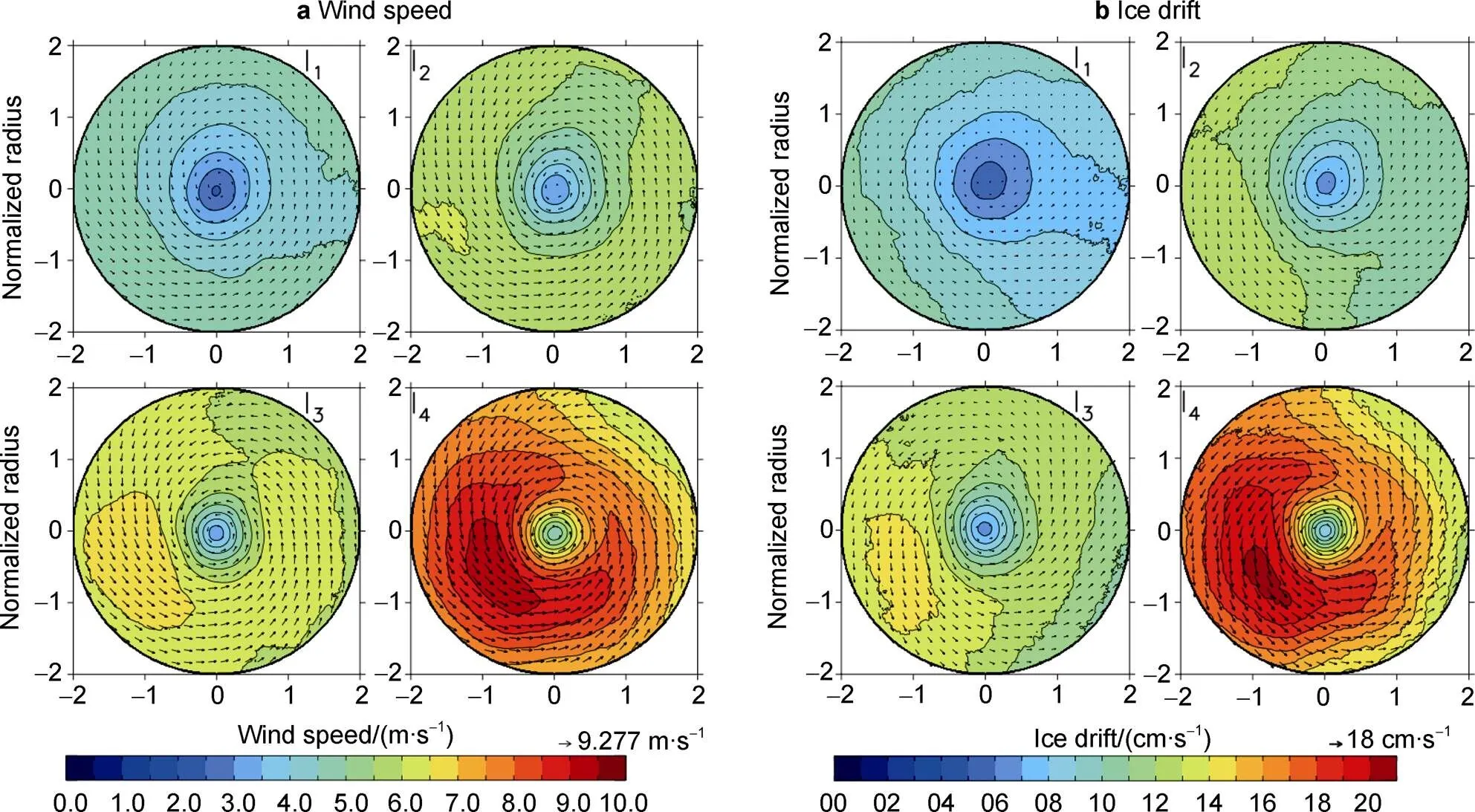
Figure 6 As in Figure 5 but for mean wind speed (a) and mean ice drift (b) for cyclone intensity classes I1to I4. Adapted from Kriegsmann (2014).
Figure 7 Trajectory of a sample cyclone (red line) that occurred in February 1995. Red dots denote the positions of the cyclone center at 6-h intervals. The climatology of winter (DJF) sea level pressure (hPa) and surface wind (m·s−1) during 1979–2012 is represented by color shading and vectors, respectively. Adapted from Wei et al. (2018).
A recent study indicated that the anticyclonic trend mentioned above is indeed a manifestation of the long-term trend of the large-scale atmospheric circulation over past decades (Figure 12) (Bi et al., 2019). Broadly, the summer anticyclone in the Arctic represents the western component of the DA, which is favorable for sea ice melting and advection processes that support reduced sea ice cover at the end of the September. Consequently, because of enhanced transport of warm moist air (Figure 12b), sea ice on the Pacific side of the Arctic Ocean is susceptible to intensive summertime melting. Examination of SLP changes suggests that DA-associated anticyclonic processes appear primarily responsible for increasing the sea ice outflow through Fram Strait in summer (Figure 12e). By contrast, NAO-associated wind patterns contribute to a lesser degree to the surface atmospheric temperature (Figures 12c vs. 12a) and SLP (Figures 12f vs. 12d) changes and thus they are less apparent than those linked to the DA.
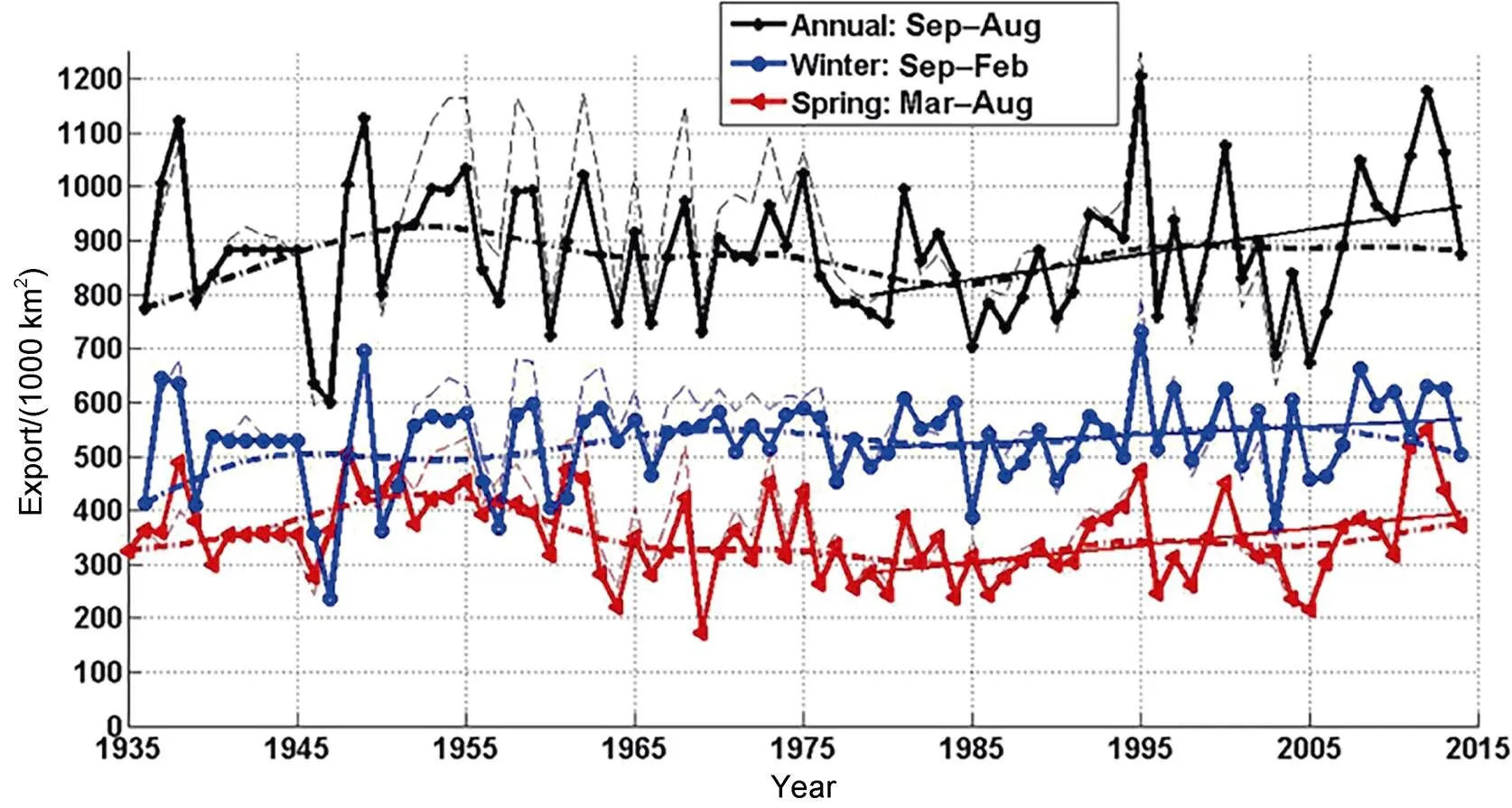
Figure 8 Southward ice area export via Fram Strait during 1935–2014. Ice export during 1935–2003 is based on the relationship between observed mean sea level pressure and ice export derived from SAR. Ice export during 2004–2014 is based solely on SAR observations. Adapted from Smedsrud et al. (2017).
Figure 9 Maps of the regression of normalized winter cyclone count (a) and cyclone center sea level pressure (b) on winter sea ice export anomaly through Fram Strait. Note that the sign in b is reversed. Areas enclosed by red and blue bold lines denote significant regression coefficient at the 90% confidence level. The identified key region in which cyclones exert greatest influence on ice export variability is marked by the black dashed line. Adapted from Wei et al. (2018).

Figure 10 Sea ice motion trend in summer during 1979–2006.
The direct impacts of anticyclonic processes on sea ice outflow through Fram Strait was assessed by Ionita et al. (2016). The occurrence of upper-atmospheric anticyclone (blocking) to the southeast of Greenland (Greenland blocking) induces a northeastward wind flow and impedes sea ice export through Fram Strait (Figure 13). By contrast, blocking events over Western Europe (European blocking) are associated with enhanced ice export (not shown) because the blocking effects on sea ice outflow diminish. It has been noted that a westward trend of development of Greenland blocking is currently emerging (Chen and Luo, 2017), and the resultant impacts on Fram Strait sea ice outflow attributable to this change require further investigation.
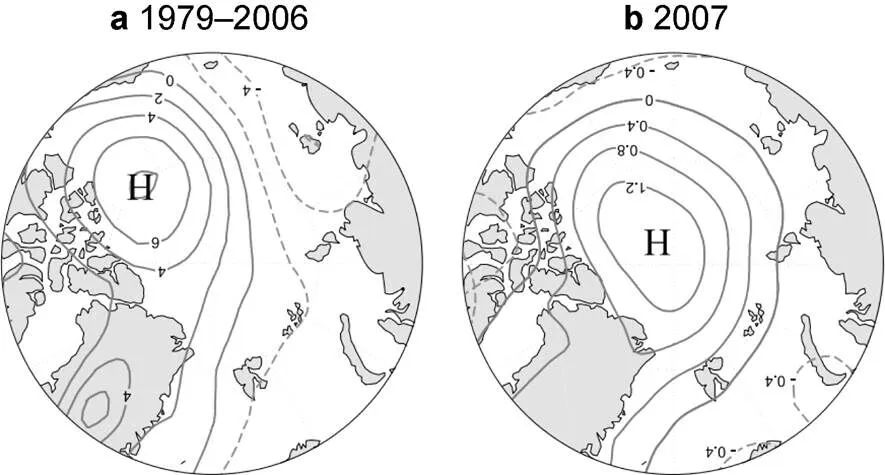
Figure 11 Maps of the regression of SLP patterns on September sea ice extent variations (a, 1979–2006) and SLP anomaly in 2007 (b). Adapted from Ogi and Wallace (2007).
Figure 12 Surface atmospheric temperature (SAT) and SLP changes associated with the Dipole Anomaly (DA) and North Atlantic Oscillation (NAO) indices. Adapted from Bi et al. (2019).
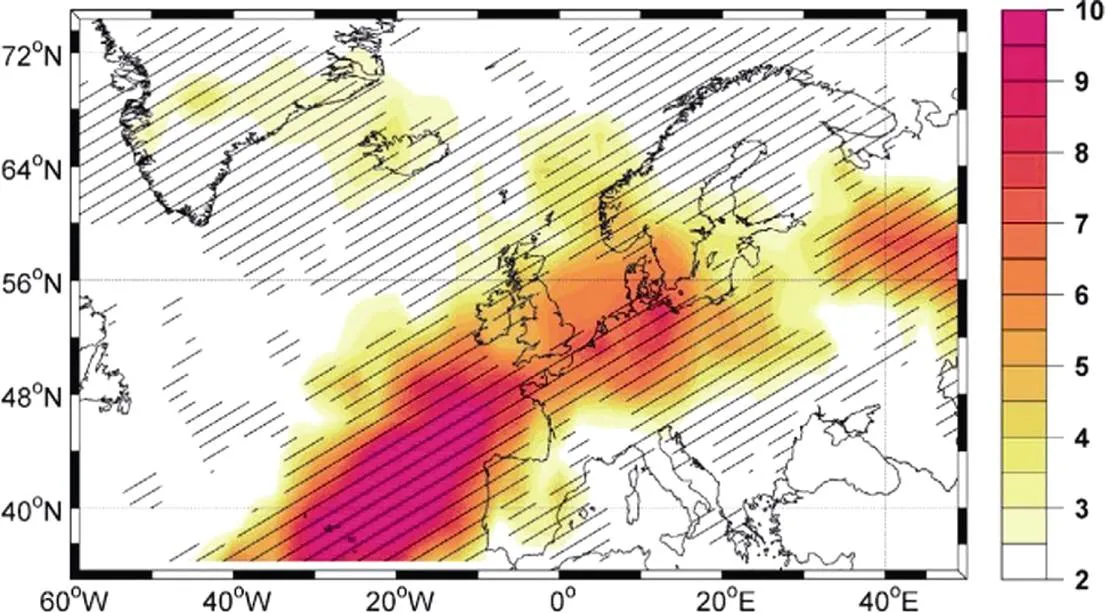
Figure 13 Frequency of anticyclones in the upper atmosphere (blocking) for sea ice volume export above a standard deviation of 0.75. Hatching highlights significant anomalies at a confidence level of 95% with a-test. Adapted from Ionita et al. (2016).
5 Discussion and conclusions
As the rate of climate change accelerates, the contributions to Fram Strait outflow related to synoptic processes are of particular interest. From the above analysis, we can conclude that both cyclonic and anticyclonic processes have distinct impact on Fram Strait sea ice outflow through influence on sea ice concentration and sea ice drift. Cyclones occurring over the southeastern Greenland Sea can significantly promote sea ice outflow through Fram Strait, while anticyclones occurring over Western Europe show similar contributions. Cyclones and anticyclones exert influence on sea ice outflow via Fram Strait primarily through control of sea ice drift. Several studies have revealed that sea ice drift is the main factor determining sea ice outflow variability. Thus, dynamic effects on sea ice outflow through Fram Strait attributable to synoptic processes (cyclones and anticyclones (or blocking)) perhaps dominate over thermodynamic effects.
Previous studies have highlighted the significance of cyclones (normally closed cyclones) in controlling sea ice outflow via the strait. However, the role of troughs of low pressure on sea ice outflow has generally been neglected. As shown in Figure 14, troughs of low pressure are commonly observed in and around the Arctic region. Therefore, the specific role of troughs of low pressure should be considered in future studies. In addition, different cyclonic parameters (e.g., intensity and track) are found to be important in influencing sea ice outflow. However, the functions of other key parameters that characterize a cyclone, such as radius and persistence (or duration), have not been examined comprehensively.
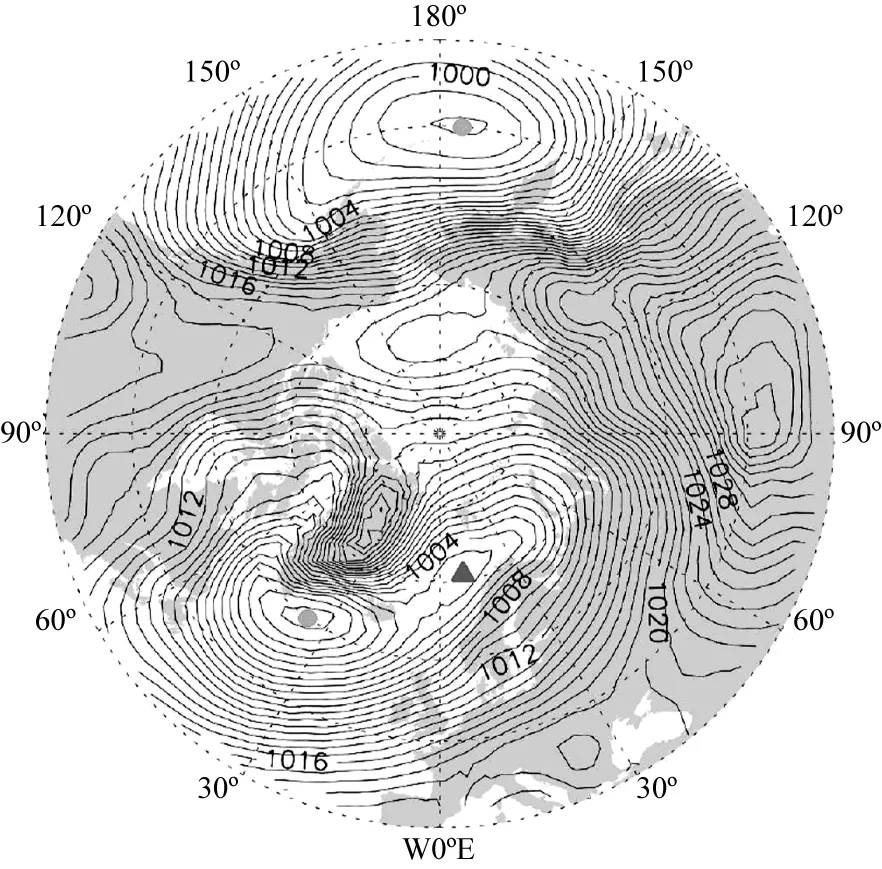
Figure 14 Typical distribution of cyclones in the Northern Hemisphere (dot: closed cyclone; triangle: trough of low pressure).
To obtain a historic estimate of sea ice outflow over as long a period as possible, the cross-strait SLP gradient (SLPG) has been adopted for its relevance to sea ice area flux (Smedsrud et al., 2017). However, the currently available statistical model of SLPG and sea ice area flux through Fram Strait needs revision for adaptation to the cyclonic surroundings. Establishing new models that consider cyclonic conditions (e.g., varying intensity, radius, as well as different tracks) will mean that the bias between modeled results and observed estimates could be reduced and reliable long-term estimates derived.
With regard to the effects of anticyclones on sea ice outflow through Fram Strait, most studies have paid close attention to summertime surface anticyclones. It has been argued that early spring snow melt and resultant upper-level atmospheric changes could be responsible for the anticyclone pattern over the Arctic Ocean (Matsumura et al., 2014). Changes in the position and intensity of the summer polar vortex might also be a connected factor (Cohen et al., 2014; Matsumura et al., 2014). Extensive summer sea ice loss around the Pacific side of the Arctic Ocean is inferred to contribute to the form of the recent DA, which broadly facilitates sea ice outflow via Fram Strait (Bi et al., 2019). The above studies have mainly drawn their conclusions based on statistical linkages between synoptic variables and sea ice outflow. However, the associated physical mechanisms underlying the linkages have not been elucidated clearly. In an upcoming study, we intend to explore the mechanisms that lead to the anticyclonic pattern in the Arctic region, primarily from the perspective of weakened potential vorticity that is associated closely with sea ice and snow loss (Luo et al., 2019).
The occurrence of an upper-level atmospheric anticyclone (blocking) over the North Atlantic Ocean is also conducive to sea ice outflow via the strait. It is noted that Greenland blocking is not entirely stationary and that it can be divided into two components: quasi stationary blocking (QSB) and westward-shifting blocking (Chen and Luo, 2017). The effects due to QSB might be direct and persistent, but the role of westward-shifting blocking in controlling the variability of sea ice outflow remains unclear. Given that changes in the position and intensity of QSB might have downstream effects on the winds associated with the TDS (Chen and Luo, 2017), we intend to investigate the quantitative contribution of QSB to TDS intensity and Fram Strait sea ice outflow in future research.
Acknowledgments This work was funded by the Natural Science Foundation of China (Grant no. 41406215). The authors thank the two anonymous reviewers for their constructive comments.
Bi H, Sun K, Zhou X, et al. 2016. Arctic sea ice area export through the fram strait estimated from satellite-based data: 1988–2012. IEEE J-STARS, 9(7): 3144-3157, doi:10.1109/jstars.2016.2584539.
Bi H, Wang Y, Zhang W, et al. 2018. Recent satellite-derived sea ice volume flux through the Fram Strait: 2011–2015. Acta Oceanol Sin, 37(9): 107-115, doi:10.1007/s13131-018-1270-9.
Bi H, Yang Q, Liang X, et al. 2019. Contributions of advection and melting processes to the decline in sea ice in the Pacific sector of the Arctic Ocean. Cryosphere, 13(5): 1423-1439, doi:10.5194/tc-13-1423- 2019.
Brümmer B. 2003. A Fram Strait cyclone: Properties and impact on ice drift as measured by aircraft and buoys. J Geophys Res, 108: 4217, doi:10.1029/2002jd002638.
Brümmer B, Hoeber H. 1999. A mesoscale cyclone over the Fram Strait and its effects on sea ice. J Geophys Res-Atmos, 104(D16): 19085-19098, doi:10.1029/1999jd900259.
Brümmer B, Müller G, Affeld B, et al. 2001. Cyclones over Fram Strait: impact on sea ice and variability. Polar Res, 20(2): 147-152, doi:10. 3402/polar.v20i2.6511.
Brümmer B, Müller G, Hoeber H. 2003. A Fram Strait cyclone: Properties and impact on ice drift as measured by aircraft and buoys. J Geophys Res-Atmos, 108(D7): 4217.
Brümmer B, Müller G, Schröder D. 2005. In situ observations in cyclones over Fram Strait. Meteorol Z, 14(6): 721-734.
Brümmer B, Schröder D, Müller G, et al. 2008. Impact of a Fram Strait cyclone on ice edge, drift, divergence, and concentration: Possibilities and limits of an observational analysis. J Geophys Res-Oceans, 113(C12), doi:10.1029/2007jc004149.
Caesar L, Rahmstorf S, Robinson A, et al. 2018. Observed fingerprint of a weakening Atlantic Ocean overturning circulation. Nature, 556(7700): 191-196, doi:10.1038/s41586-018-0006-5.
Chen X, Luo D. 2017. Arctic sea ice decline and continental cold anomalies: Upstream and downstream effects of Greenland blocking. Geophys Res Lett, 44(7): 3411-3419.
Chen X, Tung K-K. 2018. Global surface warming enhanced by weak Atlantic overturning circulation. Nature, 559(7714): 387-391, doi:10. 1038/s41586-018-0320-y.
Christensen M, Nilsson A E. 2017. Arctic sea ice and the communication of climate change. Popular Comm, 15(4): 249-268, doi:10.1080/ 15405702.2017.1376064.
Cohen J, Screen J A, Furtado J C, et al. 2014. Recent Arctic amplification and extreme mid-latitude weather. Nat Geosci, 7(9): 627-637, doi:10.1038/ngeo2234.
Comiso J C, Parkinson C L, Gersten R, et al. 2008. Accelerated decline in the Arctic sea ice cover. Geophys Res Lett, 35(1): 179-210, doi:10. 1029/2007gl031972.
Dickson B, Yashayaev I, Meincke J, et al. 2002. Rapid freshening of the deep North Atlantic Ocean over the past four decades. Nature, 416(6883): 832-837, doi:10.1038/416832a.
Dickson R R, Meincke J, Malmberg S-A, et al. 1988. The “great salinity anomaly” in the Northern North Atlantic 1968–1982. Prog Oceanogr, 20(2): 103-151, doi:10.1016/0079-6611(88)90049-3.
Francis J A, Vavrus S J. 2012. Evidence linking Arctic amplification to extreme weather in mid-latitudes. Geophys Res Lett, 39(6): L06801, doi:10.1029/2012gl051000.
Häkkinen S. 1993. An Arctic source for the great salinity anomaly: A simulation of the Arctic ice-ocean system for 1955–1975. J Geophys Res-Oceans, 98(C9): 16397-16410, doi:10.1029/93jc01504.
Haller M, Brümmer B, Müller G. 2014. Atmosphere–ice forcing in the transpolar drift stream: results from the DAMOCLES ice-buoy campaigns 2007–2009. Cryosphere, 8(1): 275-288, doi:10.5194/tc-8- 275-2014.
Heiri O, Tinner W, Lotter A F. 2004. Evidence for cooler European summers during periods of changing meltwater flux to the North Atlantic. Proc Natl Acad Sci USA, 101(43): 15285-15288, doi:10. 1073/pnas.0406594101.
Huang J, Zhang X, Zhang Q, et al. 2017. Recently amplified Arctic warming has contributed to a continual global warming trend. Nat Clim Change, 7(12): 875-879, doi:10.1038/s41558-017-0009-5.
Inoue J, Kikuchi T, Perovich D K. 2008. Effect of heat transmission through melt ponds and ice on melting during summer in the Arctic Ocean. J Geophys Res, 113(C5): C05020, doi:10.1029/2007jc004182.
Ioannidou L, Yau M K. 2008. A climatology of the Northern Hemisphere winter anticyclones. J Geophys Res-Atmos, 113(D8): D08119, doi:10.1029/2007jd008409.
Ionita M, Scholz P, Lohmann G, et al. 2016. Linkages between atmospheric blocking, sea ice export through Fram Strait and the Atlantic meridional overturning circulation. Sci Rep, 6: 32881, doi:10.1038/srep32881.
Jackson L C, Peterson K A, Roberts C D, et al. 2016. Recent slowing of Atlantic overturning circulation as a recovery from earlier strengthening. Nat Geosci, 9(7): 518-522, doi:10.1038/ngeo2715.
Jahn A, Holland M M. 2013. Implications of Arctic sea ice changes for North Atlantic deep convection and the meridional overturning circulation in CCSM4–CMIP5 simulations. Geophys Res Lett, 40(6): 1206-1211, doi:10.1002/grl.50183.
Jung T, Hilmer M. 2001. The link between the north Atlantic oscillation and Arctic sea ice export through fram strait. J Climate, 14(19): 3932-3943, doi:10.1175/1520-0442(2001)014<3932:tlbtna>2.0.co;2.
Kerr R A. 2012. Ice-free Arctic sea may be years, not decades, away. Science, 337(6102): 1591, doi:10.1126/science.337.6102.1591.
Koenigk T, Mikolajewicz U, Haak H, et al. 2006. Variability of Fram Strait sea ice export: causes, impacts and feedbacks in a coupled climate model. Clim Dyn, 26(1): 17-34, doi:10.1007/s00382-005- 0060-1.
Koyama T, Stroeve J, Cassano J, et al. 2017. Sea ice loss and Arctic cyclone activity from 1979 to 2014. J Climate, 30(12): 4735-4754, doi:10.1175/jcli-d-16-0542.1.
Kriegsmann A, Brümmer B. 2014. Cyclone impact on sea ice in the central Arctic Ocean: a statistical study. Cryosphere, 8(1): 303-317, doi: 10.5194/tc-8-303-2014.
Krumpen T, Belter H J, Boetius A, et al. 2019. Arctic warming interrupts the Transpolar Drift and affects long-range transport of sea ice and ice-rafted matter. Sci Rep, 9(1): 5459, doi:10.1038/s41598-019- 41456-y.
Krumpen T, Gerdes R, Haas C, et al. 2016. Recent summer sea ice thickness surveys in Fram Strait and associated ice volume fluxes. Cryosphere, 10: 523-534, doi:10.5194/tc-10-523-2016.
Kumar A, Perlwitz J, Eischeid J, et al. 2010. Contribution of sea ice loss to Arctic amplification. Geophys Res Lett, 37(21): 389-400, doi:10.1029/2010gl045022.
Kwok R. 2000. Recent changes in Arctic Ocean sea ice motion associated with the North Atlantic Oscillation. Geophys Res Lett, 27(6): 775-778, doi:10.1029/1999gl002382.
Kwok R. 2008 Outflow of Arctic ocean sea ice into the Greenland and Barents seas: 1979–2007. J Climate, 22(9): 2438-2457, doi:10.1175/ 2008jcli2819.1.
Kwok R, Cunningham G, Pang S S. 2004. Fram Strait sea ice outflow. J Geophys Res-Oceans, 109(C1): C01009, doi:10.1029/2003jc001785.
Kwok R, Spreen G, Pang S. 2013. Arctic sea ice circulation and drift speed: Decadal trends and ocean currents. J Geophys Res-Oceans, 118(5): 2408-2425, doi:10.1002/jgrc.20191.
Lammert A, Brümmer B, Kaleschke L. 2009. Observation of cyclone–induced inertial sea-ice oscillation in Fram Strait. Geophys Res Lett, 36(10): L10503, doi:10.1029/2009gl037197.
Lemke P, Harder M, Hilmer M. 2000. The response of Arctic sea ice to global change. Clim Change, 46 (3): 277-287.
Luo D, Chen X, Overland J, et al. 2019. Weakened potential vorticity barrier linked to recent winter Arctic sea ice loss and mid-latitude cold extremes. J Climate, 32: 4235-4261, doi:10.1175/jcli-d-18-0449.1.
Matsumura S, Zhang X, Yamazaki K. 2014. Summer Arctic atmospheric circulation response to spring Eurasian snow cover and its possible linkage to accelerated sea ice decrease. J Climate, 27(17): 6551-6558, doi:10.1175/jcli-d-13-00549.1.
McManus J F, Francois R, Gherardi J-M, et al. 2004. Collapse and rapid resumption of Atlantic meridional circulation linked to deglacial climate changes. Nature, 428(6985): 834-837, doi:10.1038/nature 02494.
Miller G H, Alley R B, Brigham-Grette J, et al. 2010. Arctic amplification: can the past constrain the future? Quat Sci Rev, 29(15): 1779-1790, doi:10.1016/j.quascirev.2010.02.008.
Müller J, Massé G, Stein R, et al. 2009. Variability of sea-ice conditions in the Fram Strait over the past 30,000 years. Nat Geosci, 2(11): 772-776, doi:10.1038/ngeo665.
Ogawa F, Keenlyside N, Gao Y, et al. 2018. Evaluating impacts of recent Arctic sea-ice loss on the northern hemisphere winter climate change. Geophys Res Lett, 45(7): 3255-3263, doi:10.1002/2017gl076502.
Ogi M, Rigor I G, McPhee M G, et al. 2008. Summer retreat of Arctic sea ice: Role of summer winds. Geophys Res Lett, 35(24): L24701, doi:10.1029/2008gl035672.
Ogi M, Wallace J M. 2007. Summer minimum Arctic sea ice extent and the associated summer atmospheric circulation. Geophys Res Lett, 34(12): L12705, doi:10.1029/2007gl029897.
Ogi M, Wallace J M. 2012. The role of summer surface wind anomalies in the summer Arctic sea ice extent in 2010 and 2011. Geophys Res Lett, 39(9), doi:10.1029/2012gl051330.
Olason E, Notz D. 2014. Drivers of variability in Arctic sea-ice drift speed. J Geophys Res-Oceans, 119 (9): 5755-5775, doi:10.1002/2014jc 009897.
Perovich D K, Grenfell T C, Richter-Menge J A, et al. 2003. Thin and thinner: Sea ice mass balance measurements during SHEBA. J Geophys Res-Oceans, 108(C3): 8050, doi:10.1029/2001jc001079.
Perovich D K, Light B, Eicken H, et al. 2007a. Increasing solar heating of the Arctic Ocean and adjacent seas, 1979–2005: Attribution and role in the ice-albedo feedback. Geophys Res Lett, 34(19): 255-268, doi:10.1029/2007gl031480.
Perovich D K, Nghiem S V, Markus T, et al. 2007b. Seasonal evolution and interannual variability of the local solar energy absorbed by the Arctic sea ice–ocean system. J Geophys Res-Oceans, 112(C3): C03005, doi:10.1029/2006jc003558.
Pohlmann H, Sienz F, Latif M. 2006. Influence of the multidecadal Atlantic meridional overturning circulation variability on European climate. J Climate, 19(23): 6062-6067, doi:10.1175/jcli3941.1.
Provost C, Sennéchael N, Miguet J, et al. 2017. Observations of flooding and snow–ice formation in a thinner Arctic sea-ice regime during the N-ICE2015 campaign: Influence of basal ice melt and storms. J Geophys Res-Oceans, 122(9): 7115-7134, doi:10.1002/2016jc012011.
Rasmussen E A, Guest P S, Davidson K L. 1997. Synoptic and mesoscale atmospheric features over the ice-covered portion of the Fram Strait in spring. J Geophys Res-Atmos, 102(D12): 13975-13986, doi:10.1029/ 96jd03361.
Ricker R, Girard-Ardhuin F, Krumpen T, et al. 2018. Satellite-derived sea ice export and its impact on Arctic ice mass balance. Cryosphere, 12(9): 3017-3032, doi:10.5194/tc-12-3017-2018.
Riihelä A, Manninen T, Laine V. 2013. Observed changes in the albedo of the Arctic sea-ice zone for the period 1982–2009. Nat Clim Change, 3(10): 895-898, doi:10.1038/nclimate1963.
Robson J, Ortega P, Sutton R. 2016. A reversal of climatic trends in the North Atlantic since 2005. Nat Geosci, 9(7): 513-517, doi:10.1038/ ngeo2727.
Rogers J C, Yang L, Li L. 2005. The role of Fram Strait winter cyclones on sea ice flux and on Spitsbergen air temperatures. Geophys Res Lett, 32(6): L06709, doi:10.1029/2004gl022262.
Schauer U, Fahrbach E, Osterhus S, et al. 2004. Arctic warming through the Fram Strait: Oceanic heat transport from 3 years of measurements. J Geophys Res-Oceans, 109(C6): C06026, doi:10.1029/2003jc001823.
Schiermeier Q. 2009. International Polar Year: In from the Cold. Nature, 457(7233): 1075-1077, doi:10.1038/4571072a.
Screen J A, Francis J A. 2016. Contribution of sea-ice loss to Arctic amplification is regulated by Pacific Ocean decadal variability. Nat Clim Change, 6(9): 856-860, doi:10.1038/nclimate3011.
Screen J A, Simmonds I. 2013. Exploring links between Arctic amplification and mid-latitude weather. Geophys Res Lett, 40(5): 959-964, doi:10.1002/grl.50174.
Screen J A, Simmonds I, Deser C, et al. 2013. The atmospheric response to three decades of observed Arctic sea ice loss. J Climate, 26(4): 1230-1248, doi:10.1175/jcli-d-12-00063.1.
Screen J A, Simmonds I, Keay K. 2011. Dramatic interannual changes of perennial Arctic sea ice linked to abnormal summer storm activity. J Geophys Res-Atmos, 116 (D15): D15105, doi:10.1029/2011jd015847.
Sepp M, Jaagus J. 2011. Changes in the activity and tracks of Arctic cyclones. Clim Change, 105 (3-4): 577-595, doi:10.1007/s10584- 010-9893-7.
Serreze M C, Barrett A P. 2008. The summer cyclone maximum over the central Arctic Ocean. J Climate, 21(5): 1048-1065, doi:10.1175/2007jc li1810.1.
Serreze M C, Barrett A P, Stroeve J C, et al. 2009. The emergence of surface-based Arctic amplification. Cryosphere, 3(1): 11-19, doi:10. 5194/tc-3-11-2009.
Serreze M C, Barry R G. 2011. Processes and impacts of Arctic amplification: A research synthesis. Global Planet Change, 77(1-2): 85-96, doi:10.1016/j.gloplacha.2011.03.004.
Serreze M C, Francis J A. 2006. The Arctic amplification debate. Clim Change, 76 (3-4): 241-264, doi:10.1007/s10584-005-9017-y.
Simmonds I, Burke C, Keay K. 2008. Arctic climate change as manifest in cyclone behavior. J Climate, 21(22): 5777-5796, doi:10.1175/2008jcli 2366.1.
Simmonds I, Keay K. 2009. Extraordinary September Arctic sea ice reductions and their relationships with storm behavior over 1979–2008. Geophys Res Lett, 36(19): L19715, doi:10.1029/2009gl039810.
Simmonds I, Rudeva I. 2012. The great Arctic cyclone of August 2012. Geophys Res Lett, 39 (23), doi:10.1029/2012gl054259.
Smedsrud L H, Halvorsen M H, Stroeve J C, et al. 2017. Fram Strait sea ice export variability and September Arctic sea ice extent over the last 80 years. Cryosphere, 11(1): 65-79, doi:10.5194/tc-11-65-2017.
Smith H J. 2017. The long reach of Arctic sea ice loss. Science, 357(6351): 561-562, doi:10.1126/science.357.6351.561-d.
Spreen G, Kern S, Stammer D, et al. 2009. Fram Strait sea ice volume export estimated between 2003 and 2008 from satellite data. Geophys Res Lett, 36(19): L19502, doi:10.1029/2009gl039591.
Stroeve J C, Maslanik J, Serreze M C, et al. 2011. Sea ice response to an extreme negative phase of the Arctic Oscillation during winter 2009/2010. Geophys Res Lett, 38(2), doi:10.1029/2010gl045662.
Swart N. 2017. Climate variability: Natural causes of Arctic sea-ice loss. Nat Clim Change, 7(4): 239-241, doi:10.1038/nclimate3254.
Thornalley D J R, Oppo D W, Ortega P, et al. 2018. Anomalously weak Labrador Sea convection and Atlantic overturning during the past 150 years. Nature, 556(7700): 227-230, doi:10.1038/s41586-018-0007-4.
Tsukernik M, Deser C, Alexander M, et al. 2010. Atmospheric forcing of Fram Strait sea ice export: a closer look. Clim Dyn, 35(7): 1349-1360, doi:10.1007/s00382-009-0647-z.
Vellinga M, Wood R A. 2002. Global climatic impacts of a collapse of the Atlantic thermohaline circulation. Clim Change, 54(3): 251-267.
Wang J, Zhang J, Watanabe E, et al. 2009. Is the Dipole Anomaly a major driver to record lows in Arctic summer sea ice extent? Geophys Res Lett, 36(5): L05706, doi:10.1029/2008gl036706.
Wang Y, Bi H, Huang H, et al. 2019. Satellite-observed trends in the Arctic sea ice concentration for the period 1979–2016. Chin J Oceanol Limnol, 37(1): 18-37, doi:10.1007/s00343-019-7284-0.
Watanabe E, Wang J, Sumi A, et al. 2006. Arctic dipole anomaly and its contribution to sea ice export from the Arctic Ocean in the 20th century. Geophys Res Lett, 33(23): L23703, doi:10.1029/2006gl 028112.
Wei J, Zhang X, Wang Z. 2018. Impacts of extratropical storm tracks on Arctic sea ice export through Fram Strait. Clim Dyn, 52 (2): 1-12.
Wei L, Qin T, Li C. 2017. Seasonal and inter-annual variations of Arctic cyclones and their linkage with Arctic sea ice and atmospheric teleconnections. Acta Oceanol Sin, 36 (10): 1-7, doi:10.1007/s13131- 017-1117-9.
Wernli H, Papritz L. 2018. Role of polar anticyclones and mid-latitude cyclones for Arctic summertime sea-ice melting. Nat Geosci, 11(2): 108-113, doi:10.1038/s41561-017-0041-0.
Wu B, Wang J, Walsh J E. 2006. Dipole anomaly in the winter Arctic atmosphere and its association with sea ice motion. J Climate, 19(2): 210-225, doi:10.1175/jcli3619.1.
Yan X, Zhang R, Knutson T R. 2017. The role of Atlantic overturning circulation in the recent decline of Atlantic major hurricane frequency. Nat Commun, 8(1): 1695, doi:10.1038/s41467-017-01377-8.
Zhang J, Lindsay R, Schweiger A, et al. 2013. The impact of an intense summer cyclone on 2012 Arctic sea ice retreat. Geophys Res Lett, 40(4): 720-726, doi:10.1002/grl.50190.
Zhang R, Delworth T L, Held I M. 2007. Can the Atlantic Ocean drive the observed multidecadal variability in Northern Hemisphere mean temperature? Geophys Res Lett, 34(2): L02709, doi:10.1029/2006gl 028683.
Zhang X. 2010. Sensitivity of Arctic summer sea ice coverage to global warming forcing: towards reducing uncertainty in Arctic climate change projections. Tellus A, 62 (3): 220-227, doi:10.1111/j.1600- 0870.2010.00441.x.
Zhang X, Lu C, Guan Z. 2012. Weakened cyclones, intensified anticyclones and recent extreme cold winter weather events in Eurasia. Environ Res Lett, 7(4): 044044, doi:10.1088/1748-9326/ 7/4/044044.
Zhang X, Sorteberg A, Zhang J, et al. 2008. Recent radical shifts of atmospheric circulations and rapid changes in Arctic climate system. Geophys Res Lett, 35(22): L22701, doi:10.1029/2008gl035607.
Zhang Z, Bi H, Sun K, et al. 2017. Arctic sea ice volume export through the Fram Strait from combined satellite and model data: 1979–2012. Acta Oceanol Sin, 36(1): 44-55, doi:10.1007/s13131-017-0992-4.
18 June 2019;
20 September 2019;
6 March 2020
10.13679/j.advps.2019.0023
: Liang Y, Bi H B, Wang Y H, et al. A review of synoptic weather effects on sea ice outflow through Fram Strait: cyclone vs. anticyclone. Adv Polar Sci, 2020, 31(1): 43-54,
10.13679/j.advps.2019.0023
, E-mail: bhb@qdio.ac.cn
杂志排行
Advances in Polar Science的其它文章
- Evaluation of ArcIOPS sea ice forecasting products during the ninth CHINARE-Arctic in summer 2018
- Atmospheric responses over Asia to sea ice loss in the Barents and Kara seas in mid–late winter and early spring: a perspective revealed from CMIP5 data
- Characterization of the parent and hydroxylated polycyclic aromatic hydrocarbons in the soil of the Fildes Peninsula, Antarctica
- An assessment of the impacts of diesel power plants on air quality in Antarctica
- Features of sea ice motion observed with ice buoys from the central Arctic Ocean to Fram Strait
- Multi-sensor data merging of sea ice concentration and thickness
